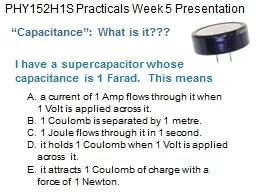

I have a supercapacitor whose capacitance is 1 Farad This means a current of 1 Amp flows through it when 1 Volt is applied across it 1 Coulomb is separated by 1 metre 1 Joule flows through it in 1 second ID: 279600
Download Presentation The PPT/PDF document "“Capacitance”: What is it???" is the property of its rightful owner. Permission is granted to download and print the materials on this web site for personal, non-commercial use only, and to display it on your personal computer provided you do not modify the materials and that you retain all copyright notices contained in the materials. By downloading content from our website, you accept the terms of this agreement.
Slide1
“Capacitance”: What is it???
I have a
supercapacitor whose capacitance is 1 Farad. This means
a current of 1 Amp flows through it when 1 Volt is applied across it. 1 Coulomb is separated by 1 metre. 1 Joule flows through it in 1 second. it holds 1 Coulomb when 1 Volt is applied across it. it attracts 1 Coulomb of charge with a force of 1 Newton.
PHY152H1S Practicals Week 5 PresentationSlide2
The “charge escalator” model of a DC battery.Slide3
Any two conducting objects separated by an insulator form a capacitor.Slide4
Capacitance and Capacitors
The ratio of the charge
Q to the potential difference ΔVC
is called the capacitance C:Capacitance is a purely geometric property of two electrodes because it depends only on their surface area and spacing. The SI unit of capacitance is the farad: 1 farad = 1 F = 1 C/V.
The charge on the capacitor plates is directly proportional to the potential difference between the plates.Slide5
Equilibrium in a simple circuit with a battery and a parallel plate capacitor:Slide6
The Energy Stored in a Capacitor
Capacitors are important elements in electric circuits because of their ability to store energy.
The charge on the two plates is ±Q and this charge separation establishes a potential difference
ΔV = Q/C between the two electrodes.In terms of the capacitor’s potential difference, the potential energy stored in a capacitor isSlide7Slide8
RC Circuits
Consider a charged capacitor, an open switch, and a resistor all hooked in series. This is an
RC Circuit. The capacitor has charge Q0 and potential difference
ΔVC = Q0/C. There is no current, so the potential difference across the resistor is zero. At t
= 0 the switch closes and the capacitor begins to discharge through the resistor.
The capacitor charge as a function of time is
where the time constant
τ
isSlide9
1 Ohm × 1 Farad = 1 second.